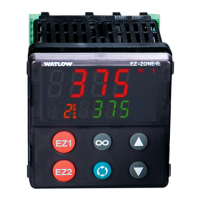Watlow EZ-ZONE
®
PMI Controller • 212 • Chapter 9 Features
Compact Assembly Class
Along with the standard implicit assembly where each module parameter (member) occupies
one 32-bit assembly location, there is also a Compact Class assembly. The need for the Com-
pact Class assembly members became apparent as the number of member instances grew
with the EZ-ZONE family of controls. Because there is a limited number of implicit assembly
members (40 input, 40 output), the Compact Class enables the user to modify the standard
assembly offering to their liking while also achieving much better utilization of each bit
within the 32-bit member. As an example, if a standard Implicit Assembly member were con-
gured to monitor Alarm State 1, the entire 32-bit member would be consumed where just
7 bits out of the 32 represent: Startup (88), None (61), Blocked (12), Alarm Low (8), Alarm
High (7) or Error (28). With Compact Class assembly member 12 (identied in this document
as "12 A, Alarm Read") in use, the alarm states of all 4 alarms can be placed in one 32-bit as-
sembly member using just 2 bits for each state. Bits 0 and 1 would represent Alarm State 1,
bits 2 and 3 Alarm State 2, etc... Each pair of 2 bits can represent the following states: 00 =
None, 01 = Alarm Low, 10 = Alarm High and 11 = Other. There is a variety of predened Com-
pact Class members that can be used (See Appendix: Compact Class Assembly Structure) to
modify the default implicit assemblies.
Note:
As is the case with any available parameter within the PM control, the Compact Class
members can also be read or written to individually via an explicit message as well.
Modifying Implicit Assembly Members
To change any given member of either assembly (T to O or O to T) simply write the new
class, instance and attribute (CIA) to the member location of choice. As an example, if it
were desired to change the 14
th
member of the T to O assembly from the default parameter
(Cool Power) to the Compact Class 12
th
member (See Appendix: Compact Class Assembly
Structure) write the value of 0x71, 0x01 and 0x0C (Class, Instance and Attribute respectively)
to 0x77, 0x02 and 0x0D. Once the change is executed, reading this member location (as was
discussed above) will return the Alarm States (1-4) to paired bits 0 through 7 where 00 =
None, 01 = Alarm Low, 10 = Alarm High and 11 = Other. The CIP communications instance will
always be instance 2.
PCCC - (Programmable Controller Communications Commands)
This protocol is typically used with older Allen Bradley programmable controllers capable of
PLC-5 compatibility. EZ-ZONE PM controllers support this protocol. As described above, the
PM has 2 assemblies; one for input (O to T), and the other for output (T to O). Within the
PM controller and as viewed and accessed using Rockwell software, these assemblies can be
identied as N11:0 (O to T) and N10:0 (T to O). Looking at the appendix in the back of this
User's Guide both assemblies are listed and identied. If for instance an ML1100 was being
used to write a new Set Point to the PM controller, a message instruction would need to be
setup within the PLC to send a oating point value to N11:2. Likewise, if it were desired to
read the Analog Input Value from the PM (within the PLC), a message instruction would need
to be setup to read (from the target device) register N10:1 and then handled appropriately
within the PLC because this is a oating point value in the PM controller.
Most, if not all of these older PLCs now support CIP generic messaging. It would be worth
your while to check and see if the PLC in use supports CIP for the programming effort will
then be minimized. Using CIP allows for reads and writes to/from the PLC directly to the
desired CIP address within the PM controller. All available PM CIP addresses are documented
within this PM User's Guide for each of the PM menus.

